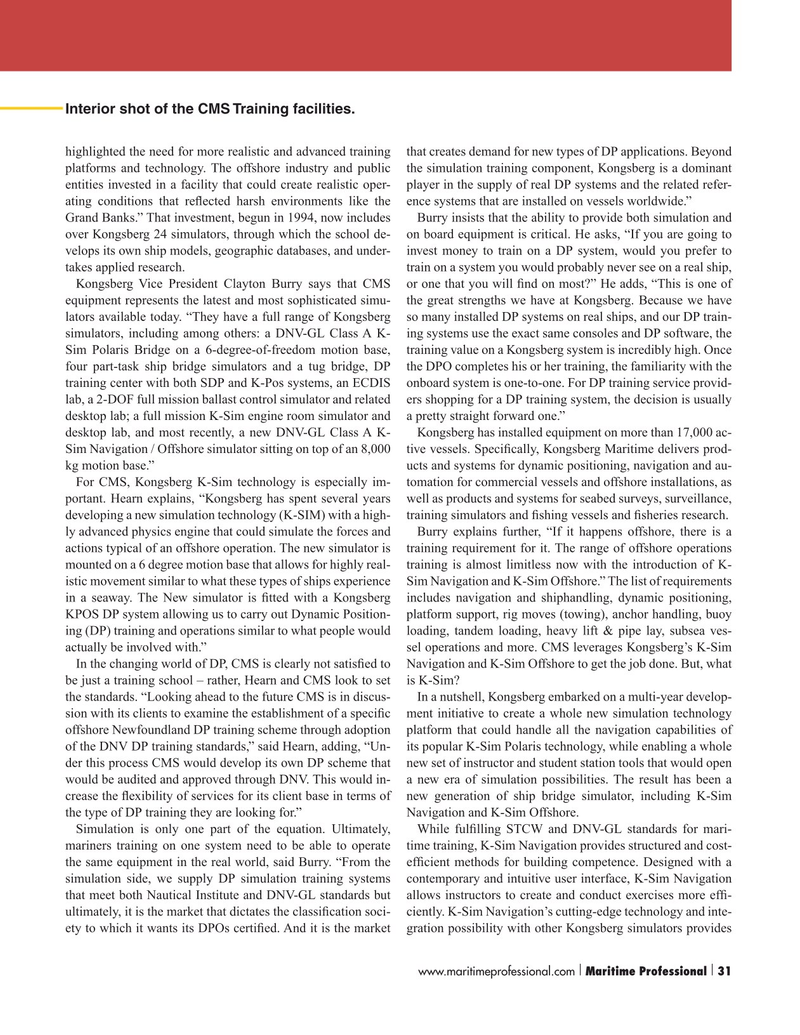
Page 31: of Maritime Logistics Professional Magazine (Q1 2016)
Maritime Training and Education
Read this page in Pdf, Flash or Html5 edition of Q1 2016 Maritime Logistics Professional Magazine
Interior shot of the CMS Training facilities.
highlighted the need for more realistic and advanced training that creates demand for new types of DP applications. Beyond platforms and technology. The offshore industry and public the simulation training component, Kongsberg is a dominant entities invested in a facility that could create realistic oper- player in the supply of real DP systems and the related refer- ating conditions that re? ected harsh environments like the ence systems that are installed on vessels worldwide.”
Grand Banks.” That investment, begun in 1994, now includes Burry insists that the ability to provide both simulation and over Kongsberg 24 simulators, through which the school de- on board equipment is critical. He asks, “If you are going to velops its own ship models, geographic databases, and under- invest money to train on a DP system, would you prefer to takes applied research. train on a system you would probably never see on a real ship,
Kongsberg Vice President Clayton Burry says that CMS or one that you will ? nd on most?” He adds, “This is one of equipment represents the latest and most sophisticated simu- the great strengths we have at Kongsberg. Because we have lators available today. “They have a full range of Kongsberg so many installed DP systems on real ships, and our DP train- simulators, including among others: a DNV-GL Class A K- ing systems use the exact same consoles and DP software, the
Sim Polaris Bridge on a 6-degree-of-freedom motion base, training value on a Kongsberg system is incredibly high. Once four part-task ship bridge simulators and a tug bridge, DP the DPO completes his or her training, the familiarity with the training center with both SDP and K-Pos systems, an ECDIS onboard system is one-to-one. For DP training service provid- lab, a 2-DOF full mission ballast control simulator and related ers shopping for a DP training system, the decision is usually desktop lab; a full mission K-Sim engine room simulator and a pretty straight forward one.” desktop lab, and most recently, a new DNV-GL Class A K- Kongsberg has installed equipment on more than 17,000 ac-
Sim Navigation / Offshore simulator sitting on top of an 8,000 tive vessels. Speci? cally, Kongsberg Maritime delivers prod- kg motion base.” ucts and systems for dynamic positioning, navigation and au-
For CMS, Kongsberg K-Sim technology is especially im- tomation for commercial vessels and offshore installations, as portant. Hearn explains, “Kongsberg has spent several years well as products and systems for seabed surveys, surveillance, developing a new simulation technology (K-SIM) with a high- training simulators and ? shing vessels and ? sheries research. ly advanced physics engine that could simulate the forces and Burry explains further, “If it happens offshore, there is a actions typical of an offshore operation. The new simulator is training requirement for it. The range of offshore operations mounted on a 6 degree motion base that allows for highly real- training is almost limitless now with the introduction of K- istic movement similar to what these types of ships experience Sim Navigation and K-Sim Offshore.” The list of requirements in a seaway. The New simulator is ? tted with a Kongsberg includes navigation and shiphandling, dynamic positioning,
KPOS DP system allowing us to carry out Dynamic Position- platform support, rig moves (towing), anchor handling, buoy ing (DP) training and operations similar to what people would loading, tandem loading, heavy lift & pipe lay, subsea ves- actually be involved with.” sel operations and more. CMS leverages Kongsberg’s K-Sim
In the changing world of DP, CMS is clearly not satis? ed to Navigation and K-Sim Offshore to get the job done. But, what be just a training school – rather, Hearn and CMS look to set is K-Sim? the standards. “Looking ahead to the future CMS is in discus- In a nutshell, Kongsberg embarked on a multi-year develop- sion with its clients to examine the establishment of a speci? c ment initiative to create a whole new simulation technology offshore Newfoundland DP training scheme through adoption platform that could handle all the navigation capabilities of of the DNV DP training standards,” said Hearn, adding, “Un- its popular K-Sim Polaris technology, while enabling a whole der this process CMS would develop its own DP scheme that new set of instructor and student station tools that would open would be audited and approved through DNV. This would in- a new era of simulation possibilities. The result has been a crease the ? exibility of services for its client base in terms of new generation of ship bridge simulator, including K-Sim the type of DP training they are looking for.” Navigation and K-Sim Offshore.
Simulation is only one part of the equation. Ultimately, While ful? lling STCW and DNV-GL standards for mari- mariners training on one system need to be able to operate time training, K-Sim Navigation provides structured and cost- the same equipment in the real world, said Burry. “From the ef? cient methods for building competence. Designed with a simulation side, we supply DP simulation training systems contemporary and intuitive user interface, K-Sim Navigation that meet both Nautical Institute and DNV-GL standards but allows instructors to create and conduct exercises more ef? - ultimately, it is the market that dictates the classi? cation soci- ciently. K-Sim Navigation’s cutting-edge technology and inte- ety to which it wants its DPOs certi? ed. And it is the market gration possibility with other Kongsberg simulators provides | | www.maritimeprofessional.com Maritime Professional 31 18-33 Q1 MP2016.indd 31 2/29/2016 10:46:57 AM

 30
30

 32
32
